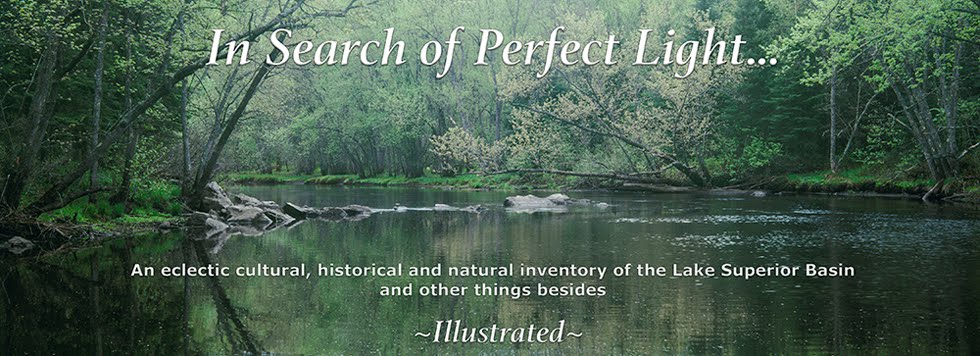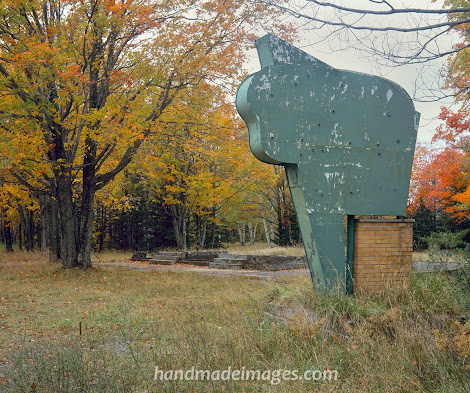Or, timing is everything...
Flowers, with Ice
When on the Superior Basin I mostly work and sometimes fish, as work
allows.
Then long about May every year, for a couple of weeks I mostly fish and
sometimes work, as fishing allows.
That's because though a freshening forest is inarguably enchanting, it's
in chilly, swollen waters that leviathans come to play. And with every passing
year, the spring song they sing compels me more.
I mostly put down the camera in May also because I realised long ago
that when viewing this magnificent landscape primarily through a narrow lens,
all authentic contact with it can be lost. May marks a willful surrender to
wildness on the more civilized calendar of my years.
This May's trip got delayed by lingering winter, which proved
considerable even by U.P. standards. Around Superior the brutal season came
early and stayed late, piling on all the while then kicking folk when they were
down. It was like tales told to youngsters by Grandpa and now tomorrow's
grandpas have tales of their own to tell, to children not yet born.
It seemed only prudent to give things a chance to recover, timing being
everything when it comes to the courting of leviathan fish. So I marked my own time...
...then arrived at the Presque Isle unit of the Porcupine Mountains
Wilderness the exact same day as did our official Upper Peninsula state bird,
the mosquito. It's like swallows returning to Capistrano every year, except U.P.
mosquitoes are bigger than swallows and eat human flesh too.
The river looked in great shape -- high and strong but clear and
dropping. Turns out, leviathans were post spawn and if you don't know what that
means for fishing, think of fish lolling around in bed smoking cigarettes while
bathed in a satisfied afterglow.
It took a lot of work just to get a bit of their attention. The second
morning suckers flooded in to have their turn and that was pretty much that for
spring river fishing.
Off I went to work. There's that fancy new Nikon and the whole
transition over to being a digital imagist, after all...
I then spent a few sublime hours
at camp lounging in an easy chair through late afternoon, reading the first
novella in Jim Harrison's The River Swimmer straight through --
a signed, 1st Edition gift given me by a dear friend. Which copy I'd dared bring
along only in hope of such perfect occasion.
With any hint of an offshore breeze, the temperature surged and the
screen on my canopy came alive with furiously buzzing mosquitoes hard to my right,
incensed that I somehow remained beyond their reach. When the breeze turned
onshore, the temperature plunged to something like 47° and scattered the angry
buggers like so many seeds to the wind.
The sun shone brilliantly throughout, fresh air rustled the spring
green trees every which way, the birds sang constantly and occasionally, an
iceberg floated by on the big lake...
It was splendid. I cooked a big steak and crawled into the tent by
8:00pm, with the sun still bright in a clear sky. Later, I'd special work to do.
And my timing had better be precisely right. I set the alarm for a quarter past
one in the morning and eventually fell asleep.
*
Throughout my entire career in film, I tried to get film to do what it
couldn't.
I shot in the dark, a lot. Sometimes even to surprising result. But
apart from a few mostly ineffectual hours spent shooting beneath a full moon, even
I wasn't dumb enough to work in the dead of night.
Digital capture's provided for that opportunity. And as with the song
of spring leviathans, I can't resist its call. We mightn't yet have agreed on a
proper name for it, but celestial landscape photography is
the sort of opportunity I've waited for my entire life.
Half past one in the morning in the wilderness is quite the thing.
Regular people don't go there. Even mosquitoes lay low. At most, some folk
are huddled around a fire, swapping tales as the great woods listens in. Most are snug in their campers or tents, trusting no wild cry in the night disturbs
their otherwise happy dreams.
Thrilled to join the night shift, I went off to work.
I shot the Presque Isle beneath the Milky Way from two separate vantages.
Neither set merits showing here, as my timing was off. Then I turned my
attention to big water and maybe learned why the early bird sings so loudly...
Lake Superior, @ the mouth of the Presque Isle River
That image was captured @ 2:22:57, pretty much the official dark of night.
Nothing but starlight was visible to my eye. Yet there, from so far beneath the
horizon that day isn't even a whisper and nearly two full hours before I could
barely see to tie a knot and fish, the sun cast unseen fire over the edge of a still
sparkling night sky.
I'm gonna dig this digital imagist stuff.
Breaking camp I was reminded that water buffalo in Africa are said to sometimes
hurl themselves off cliffs to their deaths, to escape marauding insects.
It was predicted to rain the next day couple days, then mostly didn't. I
brought the Nikon to one of my favorite spots in the Ottawa National Forest. I
was well prepared and didn't get eaten alive, though being there was like enduring
the 7th circle of Dante's Hell.
I suppose the best I got out of that was this, which is more credit to
the camera than me, 'cause it's tough to work with clouds of mosquitoes trying
to bite your eyeballs...
So I opted instead to spend quality time in my canoe at Bobcat, which
is where I ought to have been all along. Though I rarely do well there beneath
an afternoon sun, barbarian hordes of insects rarely follow out on the water
and no time spent fishing is ever wasted.
While making acquaintance with a handful of bass including one feisty
post-spawn not quite leviathan female, the light, variable breeze fell to nothing
and the entire surface of the lake captured the real world as no photographer
ever could.
The forest hushed, as if in awe of its own image on the water. A loon
came right up to me, as near as one of those shy creatures has ever been.
Apparently satisfied, she fished all around me while I watched until she'd
moved to safe distance. As a kid I once almost hooked a seagull and that was close
call enough for me.
Only for a single moment did I regret not carrying a camera. When
paddling through a small cove the beauty of everything everywhere was such that
it would've easily overwhelmed any resolve of mine to stay in the moment.
I quickly shook off the archivist in me and proceeded to loll around
through one of the prettiest evenings I've ever spent on my favorite lake, completely
undisturbed by further documentary impulses.
The sun fell as I threw my canoe atop the car. Mosquitoes tried to
exact a heavy toll, but I outran them.
The next day brought partly sunny skies, with occasional deluge.
Even the two old ladies holding fort at Randall's Bakery in Wakefield
said it was the worst year for mosquitoes in memory and their memory of such
things is considerable. It took some pretty exquisite timing on my part, to
show up just there, just then.
I'd a few more days of fishing in me, despite being too late for the
best of it. And I thought to spend the next day chasing light up the South Boundary
Road then back again, figuring that being able to compare images of where I've
been with those of where I am would prove helpful with the digital transition.
Since my last visit, someone's built a compact but spiffy new Laundromat
on the main drag in Bessemer and that's no small event. Not every local has access
to their own laundry facilities, not to mention that it saves buggy, sweat
soaked tourists a drive over to Ironwood. A local lady cheerily intent on helping
all comers to work the newfangled machines pressed half a dozen quarters into
my hand when I found myself short of change for the dryer.
Tolerating no refusal, she waved me off and said, "Pass it
on".
Being between deluges, the light was good so while my clothes tumbled
in random kindness, I went out to see.
Heading back to town required crossing the Black River. Heard it before
I saw it, which is rarely a good thing. As I crossed the bridge, two great
black birds lifted off from the far bank to hide in near bare trees. I stopped
to have a look.
Where just the day before I'd chatted with young locals fishing in
bucolic splendor, now the Black ran thick yellow brown and raged. It was freshly
attended by a pair of brazen buzzards too, hoping hungrily to claim whatever death
a flash flooded river might throw their way or for foolish fishermen to make
their eyes bulge in rapt anticipation, just the same.
It'd take days for the rivers to clear. With wind in the forecast making
the canoe no good option, what remained was the South Boundary Road, a fog of mosquitoes
and a few more hours of real life lived in the clean air of spring.
With the next clear night for to stumble around the wild in pursuit of further
celestial opportunity said to be some days away, I rather abruptly decided to
leave. So much for needing clean clothes, but no less sincere thanks to you,
local laundry maven.
Of course I wouldn't make a digital imagist of myself in a single trip,
no matter how familiar the ground. Because I'd fully intended not to try, that
was never at issue. It was fun just holding a camera in my hand again,
something the Linhof wouldn't allow.
I'd have liked the fishing to have been more robust. It'll be another
year yet again before there's a song of leviathans to answer and this last year
between proved long.
They come in autumn and occasionally other times too, when rains fall
and the river runs rich. But then the timing is even more critical, as none are
distracted by romance and the caginess that allows a fish in keen competition
with a hungry world to grow large into ripe old age remains sharp.
Still, I got what I needed if not all I wanted, a fresh shot of healthy
perspective being always helpful and a critical necessity in these, our times.
I've already marked on my more civilised calendar when the moon promises
to be new in September. Then the night will come early, stay late and maybe frost
will clear the air while turning the dark forest to crystal.
That is, if my timing's right and it doesn't rain for five straight
days, as it does with some frequency around Superior, especially in late
September.
At least I know for certain that the official state bird of the Upper Peninsula
still flies wild, staggeringly fecund and free.
Forward, boys. Ever forward...











































